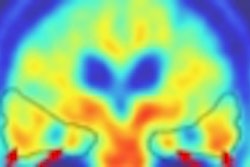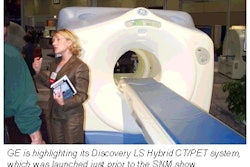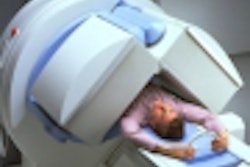TORONTO - Dementia is a progressive neurodegenerative disease that affects more than four million people in the U.S. alone, most commonly as Alzheimer's disease. While the metabolic patterns associated with dementia have been well documented with FDG-PET imaging, the results have not been well correlated with progressive cognitive decline.
The likelihood of developing Alzheimer's has been associated with a variety of metabolic, physiologic, and genetic markers, including the presence of the apoE e4 genotype. Yet for patients who are already suffering mild cognitive impairment, the specific question of who can be expected to worsen remains largely unanswered.
The question remains a critical one for patients, physicians, and the larger society, which must bear the enormous economic, social, and emotional costs associated with severe dementia.
In an effort to assess the prognostic value of FDG-PET, researchers from the University of California, Los Angeles compared cerebral metabolic patterns associated with dementia against cognitive performance as measured with the Folstein mini mental-state evaluation (MMSE), the most commonly used method of quantifying cognitive performance in clinical research.
The study, led by Dr. Daniel Silverstein from UCLA's department of molecular and medical pharmacology, was presented by co-researcher Dr. Shanna Kim at the Society of Nuclear Medicine meeting on Monday.
The MMSE test is based on a score of 30 points. A score of 24 or below indicates some degree of cognitive impairment, while a score lower than 20 indicates at least moderate cognitive impairment.
"In order to compare PET results with the MMSE scores, 152 patients were referred to the nuclear medicine clinic for dementia [evaluation] between 1991 and 1998, when the study was concluded," Kim said.
At the time of the initial evaluation, the mean age of the 152 study subjects was 66 years, with fewer than half under the age of 65, and more than a quarter over age 75. Nearly 91% of the study subjects were experiencing cognitive problems, most commonly memory deficits, Kim said.
PET scans were performed in all 152 patients, and were interpreted by a team of physicians at the institution who were blinded to all information about the subjects except for age, gender, and MRI reports when available. PET results were used to classify each patient as positive or negative for progression of functional cognitive decline according to a list of criteria, which included parietal, temporal, frontal hypometabolism, or frontal predominant hypometabolism. In 1% of patients, the physicians noted ametabolism of basal ganglia in a Huntingtons' disease pattern.
"On the other hand, those that were classified as being negative for neurodegenerative disease had either normal metabolism, global hypometobolsm, or focal hypometabolism not meeting the criteria for progressive disease," Kim said.
The scans were also read independently by a second physician, and the results were found to conform to the original interpretatoin in 94% of the cases, Kim said.
In addition to the clinical diagnosis of PET, Folstein MMSE exam scores were stratified whenever possible from patients' medical records according to the duration of time following the initial PET evaluation. Two hundred three scores were collected from 85 patients, and cross-sectional data were placed into one of three time bins corresponding to -1 to 1 year after PET, 1-3 years after PET, and 3-5 years after PET.
Based on the MMSE scores, the subjects were categorized as either positive or negative for dementia, and the results then compared to the PET findings. Of 93 patients with dementia, PET diagnosed 85 as positive for dementia. Of the 59 patients without dementia, PET diagnosed 45 subjects as negative. As a predictor of progressive disease, PET had an overall sensitivity of 91.4%, specificity of 73.3%, and an overall accuracy of 85.5%, Kim said.
"Among patients classified as being positive for progressive disease by PET, cross-sectional data demonstrated a significant decline (p<0.05) in MMSE every two years, from 22 points to 19 to 16 at time equals zero to four years, respectively," she said. "In contrast, MMSE scores of patients with negative PET did not decline significantly: from 26.5, to 25, to 24 at time equals zero, two, and four years. So although there is a decline, it is not a substantial one compared to that of [positive] PET."
Over the five-year period studied, those subjects categorized as negative for disease progression decreased at an average of only two MMSE points, while those positive for progression decreased by almost five points from the initial time of examination, according to the results. The data was not examined over longer time periods because the number of study participants would have fallen sharply, according to Kim.
"In patients undergoing evaluation for dementia, FDG PET has a high prognostic value in projecting subsequent stability or decline relative to a commonly used measure of cognitive performance," she concluded.
By Eric BarnesAuntMinnie.com staff writer
June 26, 2001
Click here to post your comments about this story. Please include the headline of the article in your message.
Copyright © 2001 AuntMinnie.com



















